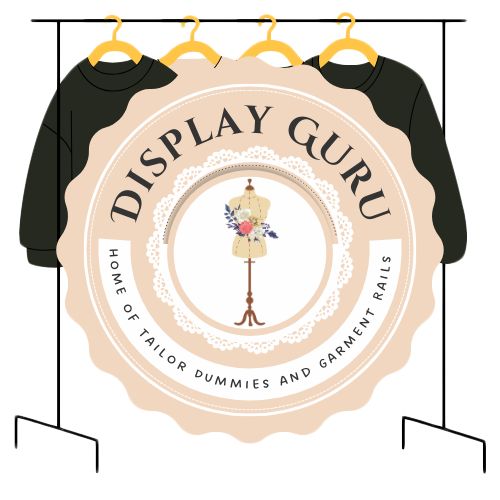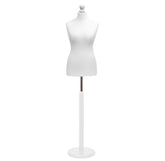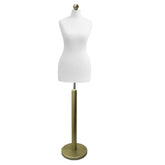Choosing Your Perfect Adjustable Tailor Dummy
Think of an adjustable tailor dummy as a personal mannequin, one you can shape to match specific body measurements. With a few turns of its built-in dials, you can change the bust, waist, and hips, creating a stand-in for a real person. It’s the tool that truly bridges the gap between a flat paper pattern and a wearable 3D garment.
Why an Adjustable Dress Form Is Your Most Important Sewing Partner

Far more than just a piece of equipment, a good adjustable tailor dummy is like a silent partner in your sewing room. Whether you’re a hobbyist just starting out or a seasoned professional, this is one tool that fundamentally changes how you build clothes, giving you a level of accuracy that a simple, static form can never offer.
Think of it as your very own fit model, one that’s always on standby and can perfectly hold any set of measurements you need. This is precisely what makes it so essential.
From Flat Pattern to Flawless Fit
The journey from a flat piece of paper to a beautifully draped garment is always a tricky one. An adjustable dummy acts as your guide, giving you a realistic, three-dimensional canvas to check your work as you go. Its main purpose is to replicate a human torso, which lets you:
- Drape fabric to experiment with new designs and create patterns from scratch.
- Check the fit of a garment at every stage, catching potential problems long before they're stitched in for good.
- Make tricky alterations with a clear, visual understanding of how your changes will hang on the final piece.
This hands-on process gives you instant feedback, which not only saves time and fabric but also results in a much more professional finish. Seeing exactly how a dart shapes the bust or how a seam curves around the hip on a body form is a game-changer compared to just guessing on a flat table.
An adjustable tailor dummy takes the guesswork out of getting the right fit. By setting the dials to precise measurements, you create a body double that ensures every seam and contour is placed with professional accuracy. It's a cornerstone of bespoke tailoring for a reason.
A Thriving Industry Tool
The value of these dress forms is clear when you look at their market presence. In fact, the UK tailor dummy and mannequin market was valued at around USD 278.2 million in 2023, a figure that highlights a robust regional industry. This number includes essential tools like the adjustable dressmaker's dummy, which remains a staple for designers, tailors, and clothing boutiques all across the UK. For those interested, you can read more about the UK mannequin market and its continued growth.
What Makes a Great Dress Form? Unpacking the Key Features
When you're ready to invest in an adjustable tailor dummy, you'll quickly realise they aren't all created equal. Knowing what separates a flimsy, basic model from a truly dependable sewing partner is the key to making a smart purchase. These details don’t just affect how long your dummy will last; they directly impact your ability to get that professional, polished finish on every garment.
Think of it this way: a cheap, wobbly form is like trying to build a house on shaky ground. A quality dress form, on the other hand, gives you a solid, accurate foundation that supports your creative vision from start to finish.
The Anatomy of a Superior Dummy
The first thing you’ll notice on any adjustable dummy is its set of adjustment dials. Most standard models come with between 8 and 12 dials to control the essential measurements: bust, waist, and hips. More advanced, professional-grade forms might offer even more, giving you nuanced control over things like torso length and neck size. What you're looking for here is smooth operation – the dials should turn easily but lock firmly in place once you've set them.
Just as important as the dials is the material covering the form. A foam-backed nylon or felt cover is the gold standard. This creates a surface that's tough enough to withstand constant use but soft enough to pin into without a fight. You need to be able to drape and secure fabric with confidence, and a good pinnable surface lets you do just that without blunting your pins or damaging the form.
The image below gives a great visual breakdown of why an adjustable model is so much more adaptable than a fixed one.

As you can see, the versatility and sheer range of sizes you can replicate with an adjustable dummy make it a far more practical choice for the long haul.
Stability and Those All-Important Extras
A dress form is only as reliable as the stand it sits on. A wobbly base is a recipe for frustration and can throw off your measurements entirely. Always look for a sturdy base – a solid metal tripod or a weighted wooden design are both excellent options. The stand absolutely must be height-adjustable too. This lets you work comfortably and ergonomically, whether you prefer to sit or stand while you sew.
Finally, it’s often the small, thoughtful additions that make the biggest difference in your day-to-day work. Many of the best forms come with a built-in hem marker. This seemingly simple tool is a lifesaver for marking a perfectly even hemline, a task that’s notoriously tricky to get right when you’re working alone.
A truly great adjustable tailor dummy comes down to three things: stability, a pinnable surface, and precise, reliable dials. Together, these features give you a tool you can count on to elevate your fitting and construction skills.
To help you decide which level of features is right for you, here’s a quick comparison.
Adjustable Tailor Dummy Feature Comparison
| Feature | Beginner Models | Intermediate Models | Professional Models |
|---|---|---|---|
| Adjustment Dials | 8 dials (bust, waist, hips) | 12 dials (adds neck/back length) | 13+ dials (adds shoulders, full back) |
| Surface Cover | Basic felt or jersey | Foam-backed nylon | Professional-grade foam & linen |
| Stand Base | Lightweight plastic or metal | Sturdy metal tripod | Heavy-duty cast iron or wood |
| Pinnability | Partial (only between panels) | Fully pinnable body | Fully pinnable, including neck & shoulders |
| Hem Marker | May not be included | Often includes a basic marker | Includes a chalk or pin hem marker |
| Additional Features | Limited | Height adjustment, 360° rotation | Caster wheels, collapsible shoulders |
Choosing a model with the right combination of these features ensures you have a tool that grows with your skills.
If you want to go even deeper into choosing the perfect model, this ultimate fitting guide for an adjustable mannequin for sewing is packed with more detailed advice. Taking the time to invest in a form with these core features will pay off massively in your sewing workflow.
How to Select the Right Size and Model

Choosing the right adjustable tailor dummy is one of the most important investments you'll make in your craft. It’s not just a case of picking a model that looks the part; it’s about finding a true partner that accurately reflects the bodies you’ll be sewing for. Getting this right from the start will save you countless headaches and fitting frustrations down the line.
The whole process starts with one critical step: taking accurate body measurements. Before you even think about browsing different models, you need a clear, honest picture of the bust, waist, and hip dimensions you work with most often. These numbers are your foundation.
Once you have them written down, you can start comparing them against the size ranges offered by different brands. And this is where a little professional inside knowledge comes in very handy.
The Golden Rule of Sizing
Always, always choose an adjustable tailor dummy that is slightly smaller than your own measurements or those of your primary client. I know it sounds counter-intuitive, but this single tip gives you the flexibility to add padding where it's needed. It is far easier to build up a smaller form to achieve a perfect, nuanced shape than it is to wrestle with a dummy that’s too large even on its smallest setting.
This approach is the only way to genuinely replicate unique body contours, like a rounded back, a full tummy, or asymmetrical hips—details the dials alone can never capture. Padding is what transforms a generic form into a precise body double.
The real secret to a perfect fit is choosing a dummy you can build upon. A slightly smaller form is the ideal canvas for padding, letting you replicate every unique curve and contour with absolute precision. It turns a standard tool into a truly bespoke fitting assistant.
If you're new to this, getting the measurements right is your first hurdle. You can get up to speed by checking out our easy guide on how to take body measurements for clothes for detailed, step-by-step instructions.
Matching the Model to the Wearer
Beyond just the numbers, the type of form you choose is vital. Adjustable tailor dummies aren't a one-size-fits-all solution; they're designed with specific body types in mind.
- Female Forms: These are the most common models, shaped to standard female proportions with clearly defined bust, waist, and hip areas.
- Male Forms: Built for creating menswear, these have broader shoulders, a flatter chest, and a much less defined waist-to-hip ratio.
- Child Forms: These are perfectly scaled down to match the proportions of children across different age ranges, making them essential for anyone creating kids' clothing.
On top of these, many brands now offer specialised models like petite or plus-size forms. These have been engineered from the ground up to reflect more specific body frames, giving you a much better starting point than a standard dummy. The industry has come a long way, with some professional models now extending up to a 54-inch bust.
You can expect these forms to retail from around £120 to £170 in the UK, but remember that padding kits are often sold separately to help you truly perfect the fit.
Bringing Your Dummy to Life: Setup and Customisation
So, your new adjustable dummy has arrived. Getting it out of the box is exciting, but that's just the beginning. The real artistry starts now, as you turn this standard form into a precise body double for yourself or your client. This customisation is the secret sauce that takes your sewing from good to truly professional.
First things first, let's get the basic measurements dialled in. It's best to work methodically here, focusing on one area at a time to avoid getting overwhelmed. I always start with the bust, then move down to the waist, and finally, the hips.
Turn the dials in small, gentle increments. Keep a tape measure handy and check your progress frequently. It's easy to overshoot the mark, so a little patience here goes a long way. This process gives you an accurate basic silhouette, which is the perfect foundation for the more detailed work to come.
The Fine Art of Padding
The dials get you close by matching the main circumferences, but they can't capture the unique contours of a real human body. Let's be honest, we aren't perfectly smooth or symmetrical. We have curves, slopes, and all sorts of individual quirks. This is where padding becomes your most powerful tool, turning a generic dummy into a true replica.
Padding is absolutely essential for capturing those personal characteristics, such as:
- Posture: A bit of batting on the upper back can beautifully replicate rounded shoulders or a slight stoop.
- Shoulder Shape: You can easily build up sloped or broad shoulders with some well-placed small pads.
- Body Contours: Need to match a fuller bust, a rounded tummy, or more prominent hips? Padding is the answer.
- Spinal Curves: You can even use layers of padding to mimic the specific curve of a spine or a swayback posture.
Think of yourself as a sculptor. You're adding volume exactly where it's needed to create a lifelike form that mirrors a real body with incredible accuracy.
The goal of padding isn't just about hitting the right numbers on a tape measure; it's about replicating shape. A well-padded adjustable dummy becomes your silent fit model, showing you exactly how fabric will hang and drape over every unique curve.
Creating a Smooth, Pinnable Surface
The secret to great padding is a smooth, seamless finish. I recommend starting with materials you can easily shape and layer, like polyester quilt batting or old foam shoulder pads. As you build up the shape, secure the pads to the dummy with pins or even a bit of tape.
Once you’re happy with the overall form, the final touch is a snug-fitting cover. A custom-sewn cover made from a firm stretch fabric works wonders. It pulls everything together, compressing the padding, smoothing out any lumps, and creating a perfect, uniform surface for pinning your patterns.
Of course, none of this matters if your dummy is wobbling all over the place. The stability of the stand is crucial, especially when you're draping and fitting. For more tips on this, you might find our guide on choosing your perfect dress form stand really helpful. This final step transforms your padded creation into a reliable, functional tool that's ready for any project you can dream up.
Mastering Advanced Fitting and Draping Techniques

Once you’ve padded and customised your adjustable tailor dummy, it’s no longer just a static form. It becomes an active partner in your creative process, a real stand-in for the human body. This is the point where you can graduate from simple fitting checks to the advanced techniques that really elevate your sewing.
The most exciting of these is draping. Forget starting with a flat paper pattern; draping is all about sculpting fabric directly onto the dress form. It's a three-dimensional approach where you pin, fold, and smooth the material to bring a design to life. This is precisely how couture fashion houses create those breathtaking, one-of-a-kind garments.
This hands-on method lets you see exactly how a piece of fabric wants to behave—how it falls, gathers, and clings to the body’s curves. Getting a feel for your materials is a game-changer, and understanding different fabric types like cotton and polyester is a fantastic starting point. Your adjustable dummy is the perfect canvas for this kind of experimentation.
Visualising Complex Pattern Alterations
Beyond creating new designs from scratch, your dummy is an incredible asset for mastering complex pattern alterations. Most sewing patterns need a tweak here or there to fit a real person, and seeing those changes in 3D makes the whole process far more intuitive.
An adjustable form gives you the confidence to tackle common but tricky fit problems head-on. For instance, you can easily handle:
- Full Bust Adjustments (FBA): It’s so much clearer to see how to add fullness to the bust without throwing off the side seams or armholes when you can do it on a form.
- Swayback Adjustments: You can literally pinch out the excess fabric at the small of the back on your dummy, showing you exactly how much to remove from the paper pattern.
- Shoulder Adjustments: Whether you’re working with sloped or square shoulders, you can pin and adjust the shoulder seams on the dummy until they sit perfectly.
This 3D visualisation takes the guesswork out of the equation. You can test your adjustments on the form before you even think about cutting into your precious fashion fabric, which saves a world of time and heartache.
Your adjustable tailor dummy is more than a fitting aid; it's a creative workspace. Use it to drape new ideas and solve complex fit problems in 3D, turning potential frustrations into design triumphs.
A Partner in Precision for All Garments
These advanced techniques aren’t just for womenswear, either. A well-adjusted male form is essential for getting the precision needed for tailored jackets and shirts, ensuring the shoulders and chest fit flawlessly. If you're working on menswear, our comprehensive tailor dummy male guide has more specific advice on that front.
By embracing these methods, your adjustable dummy truly becomes your most reliable collaborator, helping you achieve a professional finish on every single project you take on.
Caring for Your Adjustable Tailor Dummy
Think of your adjustable tailor dummy as a long-term investment in your sewing. With a bit of care, it will be your trusted partner for countless projects, year after year. A little bit of maintenance goes a long way in protecting its moving parts and keeping it looking its best.
These dress forms are more popular than ever, and for good reason. The global tailor dummy market is actually expected to hit USD 2.5 billion by 2033, a testament to how essential they’ve become for both hobbyists and professionals. You can discover more insights about this growing market to see just how valued these tools are. Taking care of yours is simply protecting a key piece of equipment.
Essential Maintenance Habits
Keeping your dummy in pristine condition doesn’t require a lot of effort, just a few good habits.
First, give the fabric cover a regular once-over to keep dust from settling in. A quick pass with a lint roller or the soft brush attachment on your vacuum cleaner is perfect for the job.
If you notice any small marks or spots, tackle them with a slightly damp cloth and a gentle fabric cleaner. It's always a good idea to test the cleaner on a hidden spot first, like the underside, just to be safe. Never use harsh chemicals or soak the fabric, as you could damage the foam and inner workings.
A well-maintained adjustable tailor dummy is more than just a tool; it's a long-term partner in precision. Consistent care ensures its dials turn smoothly and its measurements stay true, project after project.
Finally, don’t forget the adjustment mechanisms. Every now and then, use a can of compressed air to gently blow any dust or stray threads out of the dial housings and joints. This simple trick keeps everything turning smoothly and locking securely, so you can always count on its accuracy. When you’re not using it, try to store your dummy out of direct sunlight to stop the fabric from fading.
Frequently Asked Questions
Getting to grips with adjustable dress forms can throw up a few questions, particularly when you're on the hunt for the one that's just right for your sewing room. Let’s clear up some of the most common queries we hear from dressmakers and designers. Getting these details sorted will help you make the most of your new sewing partner.
An adjustable dummy is a brilliant tool, but knowing its strengths and, just as importantly, its limitations is the key to using it well. Here are the questions that crop up time and time again.
What If My Measurements Fall Between Two Dummy Sizes?
This is a classic dilemma, and the advice is always the same: go for the smaller size. It might feel a bit backwards, but trust me, it’s much easier to add padding to build up a smaller form than it is to work with a dummy that’s too big, even on its smallest settings.
Starting with a slightly smaller base gives you the freedom to add layers of wadding or foam to perfectly mimic unique body shapes. This is the secret to achieving a truly custom fit, letting you account for details like a rounded back or asymmetrical hips—things that the dials alone just can't replicate.
The golden rule of sizing is to buy a form you can build upon. Think of a smaller dummy as the perfect canvas; you can sculpt and pad it into an exact body double for precise, bespoke results.
Can I Use a Standard Adjustable Dummy for Trousers?
You can get a rough idea of the waist and hip fit, but honestly, most standard adjustable tailor dummies are just torsos. They aren't designed for fitting trousers properly. Without legs, it's impossible to check the crucial details like the crotch curve, the inseam, or how the fabric drapes around the thighs and calves.
If you're serious about making trousers, you’ll want to look at a couple of specialised alternatives:
- Bifurcated Dummies: These forms have separate, defined legs and are built specifically for fitting trousers, shorts, and jumpsuits. They're the right tool for the job.
- Full-Body Forms: While less common in adjustable models, these give you a complete silhouette from shoulders to ankles, which is ideal for a whole range of garments.
If you'd like to explore different options, you can find more information in our guide to adjustable dress forms for sewing.
How Do I Create a Smooth Surface After Padding?
Getting a smooth, professional finish after you've added padding is vital for accurate draping and pinning. The trick is to compress all your padding layers with a snug, stretch-fabric cover. Start by pinning your layers of quilt wadding or foam in place, then pull a custom-sewn or ready-made stretch cover tightly over the top. This will create a firm, even, and perfectly pinnable surface to work on.
At Display Guru, we offer a wide selection of high-quality dress forms to suit every sewing professional and enthusiast. Find the perfect adjustable tailor dummy to bring your creative vision to life by exploring our collection at https://www.displayguru.co.uk.








